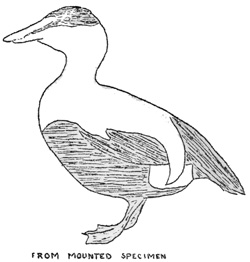|
NATURE NOTES FROM ACADIA
| Volume 4 |
January-February, 1935 |
Number 1 |

American Eider. - On February 10 in the immediate vicinity of
the bell buoy which rings rising and falling on the sea just off Otter
Cliffs, it was the good fortune of Mr. Vernon Lunt and I to see a great
flock of American Eiders. These birds, among the largest of the northern
sea-fowl which winter off the Maine coast, described a great living are
on the surface of the deep blue water. Looking them over with a
telescope I estimated there must be approximately 5000 birds in the
flock. The clean white upperparts and the black under-plumage of the
male birds contrasted with the plain brown of the females presented a
gala spectacle, for few birds are more handsome than those big male
eiders. Here, off Otter Cliffs, I have seen them time and again in the
winter, but never in such numbers. In all probability they come to the
ledges here and elsewhere to feed on mussels - a food which these birds
appear to hold in great favor.
Eiders are to be found in great flocks in the vicinity of Schoodic
Peninsula, and here the fishermen call them "sea-ducks" and "ducks and
drakes." I am told they are to be found as far out at sea as the
fishermen venture with their little craft.
-A. S.
The Snow Moon. - With snow falling on at least 12 of the 31
days, January was indoed the "Snow Moon" - a name applied to the month
by some of our American Indians. Following four consecutive days of
thawing weather the mountains were practically clear of all snow and ice
on January 9, but thereafter the month was very cold with temperatures
dropping close to zero or below on 14 of the 31 days. Late in the month
the coves and smaller harbors froze over and acres of "pancake ice"
formed in the bay. Goldeneyes and buffleheads congregated in the open
waters off Bar Harbor in abnormal numbers, and a flock of 15 scaup ducks
put in their first appearance of the winter. Flocks of herring gulls
invaded the island towns, a lighting in the streets if food of any kind
was to be had.
-A. S.
Donation. - Mounted specimens of the Canadian Spruce Grouse and Greater
Yellowlegs were recently donated to Acadia National Park's natural history
collection by Mr. and Mrs. George F. Berry of Bar Harbor. In former years the
Spruce Grouse was a resident on Mount Desert Island, but since the latter part
of the past century its occurrence here has been accidental. The Yellowlegs
is to be expected as a regular migrant. We are very grateful for this donation.
-A. S.
| 
